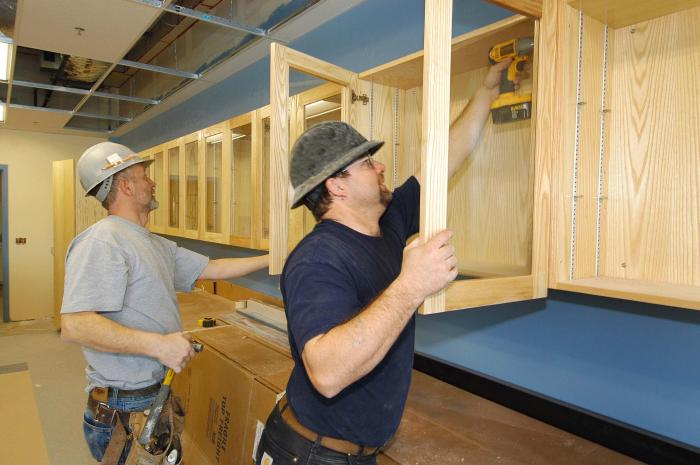
About
Ask yourself...
- Do you like working with wood?
- Are you good with your hands?
- Are you creative with an eye for detail?
- Could you visualize a finished product by looking at drawings or blueprints?
- Are you strong and physically fit?
If the answer to these questions is yes, then a career as a Cabinetmaker could be right for you.
Cabinetmakers build, repair and install wooden cabinets, furniture and fixtures. They are employed by custom furniture manufacturers, construction companies and cabinetmaking contractors, or they may be self-employed.
Duties
As a Cabinetmaker your duties may include the following:
- Operating woodworking machines and using hand tools to cut, shape and form wood
- Fitting parts together using glue and clamps
- Reinforcing joints using nails or screws
- Trimming joints
- Sanding wooden surfaces and applying veneer, stain or polish to finished products
- Repairing or restyling wooden furniture or fixtures
- Marking outlines or dimensions on wood
- Preparing or interpreting drawings or blueprints
- Preparing work estimates
Work Conditions
The standard work week for cabinetmakers is 40 hours (8 hours a day, 5 days a week). As with many careers in construction, there are peak periods that will require you to work overtime. The number of additional hours you work each week depends on the construction sector and region you work in, and will vary from one job to the next.
As a Cabinetmaker you will work indoors, either alone, in teams or with helpers. The job can be physically demanding and often involves working with high-speed woodworking machinery.
As with all careers in the construction industry, safety is the top priority. Cabinetmakers are trained to work safely and wear special equipment to protect against injury.
Training and Certification
Apprenticeship
Apprenticeship involves both classroom studies and on-the-job training under the supervision of a certified Cabinetmaker, called a journeyperson.
As an apprentice, you earn while you learn and are paid by the hour while working on the job site. Wages start at about 55 per cent of a journeyperson’s hourly rate and increase during your apprenticeship until you reach the full rate.
Entering an apprenticeship program
Requirements for cabinetmaker apprenticeship programs vary across Canada. In most provinces and territories, you must be at least 16 years old and have a Grade 12 education or equivalent to enter a cabinetmaking apprenticeship program.
Some provinces and territories offer secondary school apprenticeship programs that allow high school students to work towards a career as a Cabinetmaker.
For more information, check out the apprenticeship section.
Program length
Cabinetmaker apprenticeship programs vary across Canada, but generally involve four 12-month periods, including at least 5,440 hours of on-the-job training, four eight-week blocks of technical training and a final certificate exam.
Related work experience or completion of a cabinetmaker program at a college or technical institute can reduce the time required to complete your apprenticeship.
Certification
Certification is not required. It is available but voluntary in Alberta, British Columbia, Manitoba, New Brunswick, Newfoundland and Labrador, the Northwest Territories, Nova Scotia, Ontario, Prince Edward Island and the Yukon.
Where certification is not available, it may be possible to study as an apprentice through your local labour organization. Check out Related links to find out who to contact.
Even where certification is voluntary, it is still recommended. Certification tells employers and other workers that you are a skilled professional. It also helps you get jobs.
To be certified as a Cabinetmaker, you usually need to complete a four-year apprenticeship program. Once you successfully complete the required on-the-job training, technical training and exams, you are awarded a journeyperson certificate.
You may be eligible for certification in some provinces and territories if you have more than four years of on-the-job experience and some high school, college or industry courses in cabinetmaking.
Once certified as a Cabinetmaker, you may write the Interprovincial Exam to qualify for the Interprovincial Standards’ Red Seal. With a Red Seal, you can work as a Cabinetmaker anywhere in Canada.
To keep your skills current, Cabinetmakers must keep up with new technology developments by reading and speaking to other cabinetmakers.
Courses
Wage
 | ||
| Mid range $45,760 |  | High range $71,760 |
The “mid range” wage is based on the national “median” wage reported in the Job Bank career profile for this National Occupational Category (NOC): 7272
Note: Some career profiles may have more than one NOC code associated with them.







